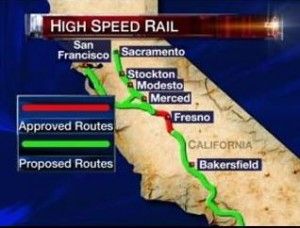LAO questions legality of plan to use cap-and-trade $ on bullet train
by Katy Grimes | January 14, 2014 11:35 am
The governor’s just-released 2014-15 budget[1] proposes to spend $850 million from cap-and-trade auction revenue on various projects — including the state’s high-speed rail project. That would defy the very purpose of cap-and-trade[2].
 [3]
[3]
In a new report on the spending plan[4], the Legislative Analyst’s Office said Jerry Brown’s proposal to use cap-and-trade funds for high-speed rail is unlikely to maximize greenhouse gas emission reductions, which was the entire stated purpose of AB 32[5] and the cap-and-trade program.
Under AB 32[5], the California Air Resources Board created a regulation that establishes a cap-and-trade program[6], to help lower carbon emissions in California. AB 32 is the Global Warming Solutions Act[7], passed in 2006 by the state Legislature and signed into law by Gov. Arnold Schwarzenegger. The goal is to reduce greenhouse gas emissions in the state to 1990 levels by 2020.
Cap-and-trade [8]was established to help achieve this goal. The regulation places a “cap” on aggregate greenhouse gas emissions from businesses and entities responsible for approximately 85 percent of the state’s emissions.
In the implementation the cap-and-trade program, the California Air Resources Board[9] allocates a certain number of carbon allowances to the businesses. According to the CARB, each allowance equals one ton of carbon dioxide equivalent. The CARB provides some allowances for free to designated businesses. Other businesses are required to purchase allowances at auctions. Once the allowances have been allocated, entities can then “trade,” buy and sell the allowances, in order to obtain enough to cover their total emissions for a given period of time.
From the LAO report[10]:
In order to minimize the economic impact of cap-and-trade, it is important that auction revenues be invested in a way that maximizes GHG emission reductions. Maximizing emission reductions (specifically in the capped sectors) reduces competition for allowances, thereby putting downward pressure on the price of allowances. This, in turn, reduces the overall cost for covered entities to comply with AB 32 and the potential negative economic impacts of the program on consumers, businesses, and ratepayers. It is, however, unclear to what extent the complement of activities proposed by the Governor maximizes GHG emission reductions.
college essays writing services[11]The LAO warns[12] the Legislature there are legal risks with Brown’s plan to use cap-and-trade auction funds for funding high-speed rail:
Based on an opinion that we received from Legislative Counsel, the revenues generated from ARB’s cap–and–trade auctions are considered “mitigation fee” revenues. Thus, the use of these revenues are subject to certain legal criteria. Specifically, we are advised that their use is subject to the so–called Sinclair nexus test. This test requires that a clear nexus must exist between an activity for which a mitigation fee is used and the adverse effects related to the activity on which that fee is levied. Given this legal requirement, the administration’s proposal to fund activities (such as high–speed rail) could be legally risky. While the high–speed rail project could eventually help reduce GHG emissions somewhat in the very long run, it would not help achieve AB 32’s primary goal of reducing GHG emissions by 2020.
High-speed rail will not reduce carbon emissions
The Legislative Analyst’s Office warned in 2008 that the high-speed rail project would initially increase greenhouse gas (GHG) emissions for many years.
Following up, a greenhouse gas emission analysis[13] done by the High Speed Rail Authority in 2013 indicates that once the high-speed rail system is completed and operational in 2022, it would contribute a relatively minor amount of GHG emission reductions.
The bullet-train project[14] was touted as a way to dramatically reduce these emissions. Yet even after contrary reports, the governor still insists the project is green. “The high-speed rail is a reducer of greenhouse gases, an enhancement of the quality of California life and a bringing together of our various communities around the state,” Brown said at his budget press conference Thursday[15]. He said because the state's population will grow by millions of residents, “we need alternatives.”
But as the LAO has consistently warned since 2008, and has does again with its new report[16], the construction of the project would actually produce additional emissions:
Despite these findings, roughly 30 percent of the funding in the Governor’s proposal goes to the high–speed rail project. Compared to a different mix of investments that could be made with the cap–and–trade revenue, the governor’s proposal is unlikely to maximize GHG emission reductions. Therefore, the Legislature will need to consider the most effective use of the cap–and–trade auction revenue.
- overnor’s just-released 2014-15 budget: http://www.ebudget.ca.gov/FullBudgetSummary.pdf
- cap-and-trade: http://www.arb.ca.gov/cc/capandtrade/capandtrade.htm
- [Image]: http://calwatchdog.com/wp-content/uploads/2013/08/high-speed-rail-map-320.jpg
- new report on the spending plan: http://lao.ca.gov/reports/2014/budget/overview/budget-overview-2014.aspx
- AB 32: http://www.arb.ca.gov/cc/ab32/ab32.htm
- cap-and-trade program: http://www.arb.ca.gov/cc/capandtrade/capandtrade.htm
- AB 32 is the Global Warming Solutions Act: http://AB%2032%20is%20the%20Global%20Warming%20Solutions%20Act
- Cap-and-trade : http://www.arb.ca.gov/cc/capandtrade/capandtrade.htm
- California Air Resources Board: http://www.arb.ca.gov/homepage.htm
- LAO report: http://lao.ca.gov/reports/2014/budget/overview/budget-overview-2014.aspx
- college essays writing services: http://collegeessayservices.net/
- LAO warns: http://lao.ca.gov/reports/2014/budget/overview/budget-overview-2014.aspx
- greenhouse gas emission analysis: http://www.hsr.ca.gov/docs/programs/green_practices/HSR_Reducing_CA_GHG_Emissions_2013.pdf
- The bullet-train project: http://ballotpedia.org/California_Proposition_1A,_High-Speed_Rail_Act_(2008)
- budget press conference Thursday: http://www.modbee.com/2014/01/09/3127334/capitol-alert-brown-says-cap-and.html#storylink=cpy
- new report: http://lao.ca.gov/reports/2014/budget/overview/budget-overview-2014.aspx
Source URL: https://calwatchdog.com/2014/01/14/lao-questions-legality-of-plan-to-use-cap-and-trade-on-bullet-train/